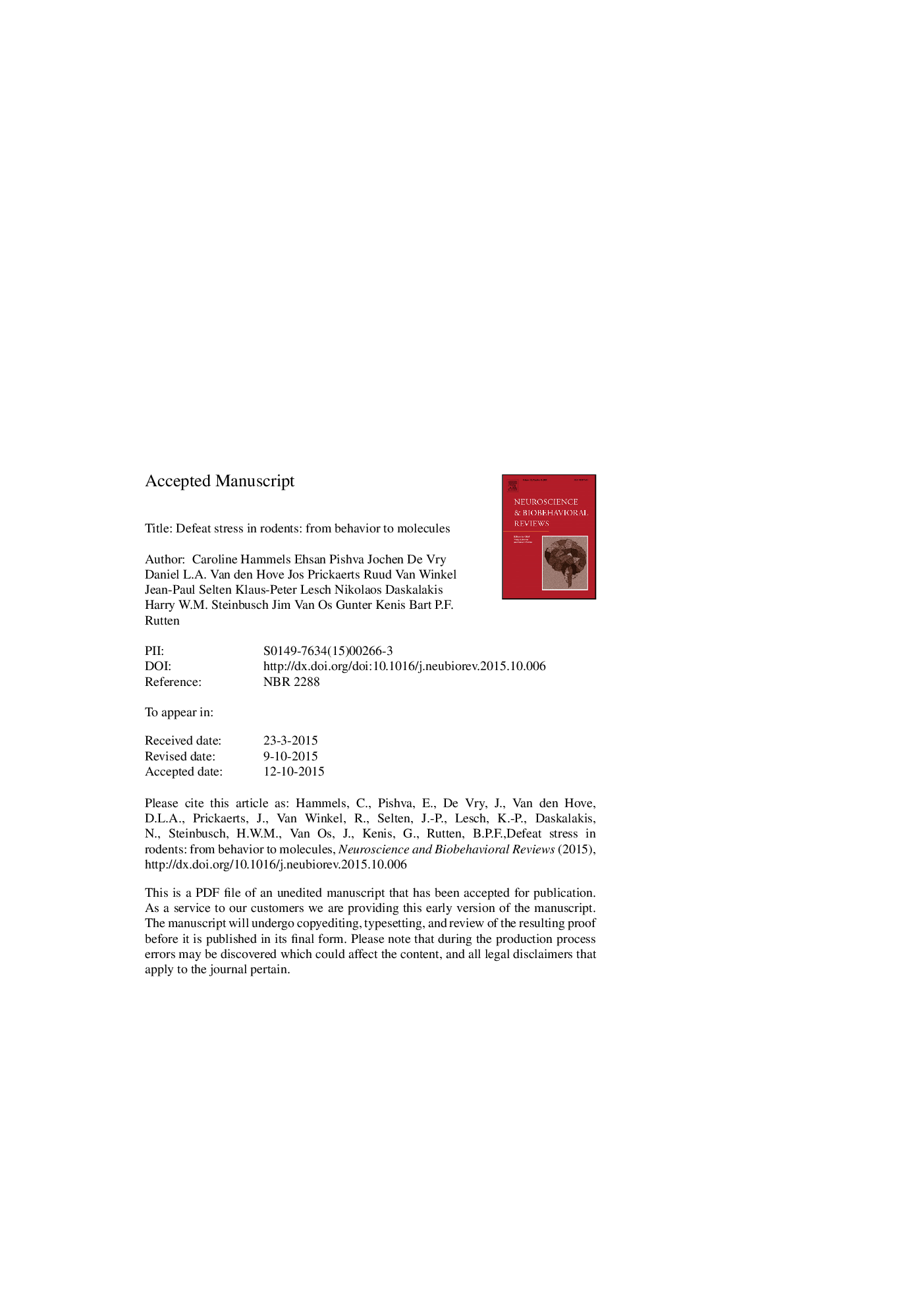| کد مقاله | کد نشریه | سال انتشار | مقاله انگلیسی | نسخه تمام متن |
|---|---|---|---|---|
| 7303167 | 1475311 | 2015 | 61 صفحه PDF | دانلود رایگان |
عنوان انگلیسی مقاله ISI
Defeat stress in rodents: From behavior to molecules
ترجمه فارسی عنوان
استرس را در جوندگان شکست دهید: از رفتار به مولکول
دانلود مقاله + سفارش ترجمه
دانلود مقاله ISI انگلیسی
رایگان برای ایرانیان
کلمات کلیدی
شکست اجتماعی، مهاجم ساکن فشار، مدل حیوانی، اختلالات روانی،
ترجمه چکیده
اختلالات رفتاری و اضطراب شرایط شایع در طول زندگی یک نفر از چهار نفر است. توسعه مدلهای حیاتی معتبر برای مطالعه این اختلالات، یک چالش بزرگ در گذشته بوده است. با توجه به رویکردهای تجربی برای مطالعه اختلالات عاطفی، پارادایم شکست اجتماعی نشان داده شده است که دارای اعتقادات اخلاقی، پیش بینی و روایی است. در اینجا، اصل کلی پارادایمهای تنش شکست اجتماعی را با تمرکز قوی بر مدل مهاجم ساکن و مقایسه شرایط مختلف آزمایشگاهی که تا به امروز منتشر شده است، توضیح می دهیم. ما در مورد تغییرات رفتاری در حیوانات شکست خورده و همچنین تغییرات پارامترهای فیزیولوژیکی حیوان بحث خواهیم کرد. علاوه بر این، ما یک مرور کلی از سازگاری های مولکولی را که در حیواناتی که در معرض استرس شکست قرار می گیرند، ارائه می کنیم، با توجه ویژه به مدار های عصبی و سیگنال های نوروندوکرین. شکست رفتارهای خاصی شبیه نشانه ها و علائم انسان هایی با اختلالات عاطفی مانند انهدونی، اجتناب اجتماعی، ناامیدی و اضطراب ایجاد می کند. این می تواند به طیف گسترده ای از تغییرات فیزیولوژیکی مرتبط باشد - از تغییرات قلب و عروق تا تغییرات در سیستم ایمنی بدن یا اختلالات در سیستم های انتقال دهنده خاص، به ویژه سروتونین و دوپامین. مدل استرس شکست در نتیجه بر چندین زمینه عملکردی تاثیر می گذارد و می تواند ویژگی های اصلی بسیاری از اختلالات روانپزشکی مانند افسردگی، اختلال استرس پس از سانحه و اسکیزوفرنی را تقلید کند. این مقاله به طور انتقادی از یافته های اصلی، نقاط قوت و ضعف دامنه مطالعات حیوانی در این زمینه و دیدگاه های آینده را بررسی می کند.
موضوعات مرتبط
علوم زیستی و بیوفناوری
علم عصب شناسی
علوم اعصاب رفتاری
چکیده انگلیسی
Mood and anxiety disorders are prevalent conditions affecting one out of four people during lifetime. The development of high validity animal models to study these disorders has been a major challenge in the past. When considering experimental approaches for studying affective disorders, the social defeat paradigm has been shown to have etiological, predictive and face validity. Here, we explain the general principle of social defeat stress paradigms, with a strong focus on the resident-intruder model and compare different experimental settings as published to date. We discuss behavioral changes described in defeated animals as well as changes in the animal's physiological parameters. In addition, we provide an overview of the molecular adaptations that are found in animals subjected to defeat stress, with special attention to neural circuits and neuroendocrine signaling. Defeat produces specific behaviors resembling the signs and symptoms of humans with affective disorders, such as anhedonia, social avoidance, despair and anxiety. These can be linked to a wide range of physiological changes-ranging from cardiovascular changes to alterations in the immune system- or by disturbances in specific neurotransmitter systems, in particular serotonin and dopamine. The defeat stress model thus impacts on several functional domains of behavior and may mimic cardinal features of a multitude of psychiatric disorders including depression, post-traumatic stress disorder and schizophrenia. This manuscript critically reviews the core findings, strengths and limitations of the range of animal studies in this field and provides future perspectives.
ناشر
Database: Elsevier - ScienceDirect (ساینس دایرکت)
Journal: Neuroscience & Biobehavioral Reviews - Volume 59, December 2015, Pages 111-140
Journal: Neuroscience & Biobehavioral Reviews - Volume 59, December 2015, Pages 111-140
نویسندگان
Caroline Hammels, Ehsan Pishva, Jochen De Vry, Daniel L.A. van den Hove, Jos Prickaerts, Ruud van Winkel, Jean-Paul Selten, Klaus-Peter Lesch, Nikolaos P. Daskalakis, Harry W.M. Steinbusch, Jim van Os, Gunter Kenis, Bart P.F. Rutten,
